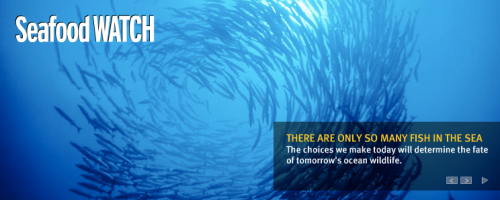Dear People of the Earth,
Stop killing and eating us or most of us may die by 2050.
Thanks,
The Fish
– A fictional letter from the
Fictional Representative of Fish to the United Nations
****
Non-fiction
In the article UN issues ‘final wake-up call’ on population and environment, the executive director of the UN Environment Program Achim Steiner, “warned of a global collapse of all species being fished by 2050, if fishing around the world continued at its present pace.”
“The human population is living far beyond its means and inflicting damage on the environment that could pass points of no return.”
This is not a quote from an activist group like Greenpeace. This quote was from a major report from the United Nations. I really hope that wasn’t our final wake-up call.
Seafood watch

What’s for dinner? Let the pocket guide help you decide. Source: http://www.montereybayaquarium.org
I went out to dinner with friends who visited the famous Monterey Bay Aquarium, CA, and showed me their Seafood Watch pocket guide. Now, I carry the guide in my wallet. The seafood guides “help make choices that are good for you and the ocean,” according to Seafood Watch. The useful pocket guides have been helping me make sustainable seafood selections at stores or restaurants, based on scientific data on mercury toxicity, endangered species, and destructive fishing methods.
What is Seafood Watch?
“A program of Monterey Bay Aquarium designed to raise consumer awareness about the importance of buying seafood from sustainable sources. We recommend which seafood to buy or avoid, helping consumers to become advocates for environmentally friendly seafood.”
The Seafood Watch website includes searchable seafood database, downloadable pocket guides, guides for business owners, and form letters for encouraging your local restaurants and stores to offer sustainable seafood.
The guide made me conscious about humanity’s effect on fish and our consumption of fish. Again, I am reminded of the circle of life, to which as a consumer I can often feel disconnection. The last time I actually caught my own fish to eat was at Cape Cod, MA when I was a child. I rarely eat fish these days, and when I do it is usually at a restaurant.
The UN report on the possible global collapse of fish was made in 2007. I’ve been puzzled by the absence of a major US government plan to meet global warming and related urgent environmental challenges. I’ve been trying to do what I can and vote as a consumer to help. Along with making sustainable seafood choices when I dine out and buy seafood, I also wrote to our local popular sushi restaurant Kirala and dropped off a seafood pocket guide to its take-out branch, Kirala 2 with a friendly letter. So far, I have heard no response from them, but hope that others will be inspired to write to them too. We do have much power not only as voters but also as consumers. I do believe that awareness on smart seafood choices can be spread quickly among communities, before it is too late. I hope to avert the possible future where my children and grandchildren grow up in a world without the fish that were once commonplace in our oceans.
What can I do to help?
Encourage your favorite restaurant to serve ocean- friendly seafood (friendly form letters)
Download a seafood watch pocket guide
Download a sushi guide with Japanese names of fish
Note: The pocket guides are also available at the Ecology Center table at the Berkeley Farmers’ Market, CA.
Articles
‘Only 50 years left’ for sea fish


